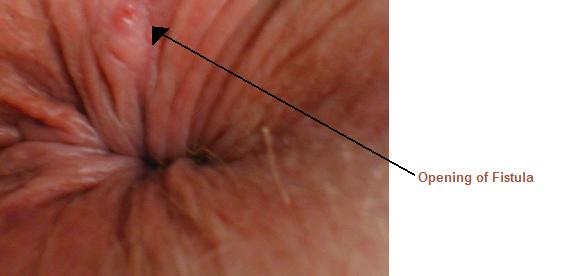- What is Anorectal Abscess and Fistula-in-Ano
- Statistics on Anorectal Abscess and Fistula-in-Ano
- Risk Factors for Anorectal Abscess and Fistula-in-Ano
- Progression of Anorectal Abscess and Fistula-in-Ano
- Symptoms of Anorectal Abscess and Fistula-in-Ano
- Clinical Examination of Anorectal Abscess and Fistula-in-Ano
- How is Anorectal Abscess and Fistula-in-Ano Diagnosed?
- Prognosis of Anorectal Abscess and Fistula-in-Ano
- How is Anorectal Abscess and Fistula-in-Ano Treated?
- Anorectal Abscess and Fistula-in-Ano References
What is Anorectal Abscess and Fistula-in-Ano
Anorectal abscess and fistula-in-ano occur in the rectum and anus.
An abscess is a localised collection of pus. In this case, it can either occur near the anus close under the skin, or deeper, adjacent to the rectum.
A fistula is an abnormal communication/track between two epithelial surfaces – in the case of fistula-in-ano, between the ano-rectal passage and the surface skin near the anus. It occurs as a complication of an ano-rectal abscess which has discharged to the skin, with the track from anorectal passage to the skin remaining patent.
Statistics on Anorectal Abscess and Fistula-in-Ano
Perianal abscesses are common conditions. Their exact incidence is unknown.
A fistula-in-ano complicates 30-50% of perianal abscesses. They are more common in patients with inflammatory bowel disease (in particular Crohn’s disease) and diabetes mellitus.
Risk Factors for Anorectal Abscess and Fistula-in-Ano
Perianal abscesses occur as a result of a blocked anal gland that subsequently becomes infected – and thus an abscess forms. They are more common in patients with diabetes mellitus, Crohn’s disease, and patients who are immunocompromised for any reason.
Fistula-in-ano frequently complicates the above conditions, but it can also be idiopathic (of unknown cause), or arise in patients with tuberculosis, trauma (especially obstetric – after traumatic delivery), carcinoma, pelvic inflammatory disease, radiation damage (post radiotherapy).
Progression of Anorectal Abscess and Fistula-in-Ano
Anorectal abscess if left alone will discharge to the skin, but then the complication of fistula-in-ano will often (30-50%) occur, which will not heal spontaneously. Surgical treatment is, however, usually successful. Neglected fistulas can result in repeated abscesses, multiple openings and complications.
Symptoms of Anorectal Abscess and Fistula-in-Ano
Pain and swelling in the anal region with wetness and soiling, often on a background of Crohn’s disease. In the acute setting, the abscess causes pain and swelling which occurs when sitting and is aggravated by motion, coughing and straining. Fever, diarrhoea, purulent discharge and bleeding may also occur. The pain is throbbing, continuous and worsened by bowel motions. The discharge on the skin causes erosion, excoriation and pruritis.
Chronic fistula may present with discharge on the buttocks and pruritis, and the pain is usually less prominent.
How is Anorectal Abscess and Fistula-in-Ano Diagnosed?
No general investigations are required for the diagnosis of the above conditions. A full blood count and blood sugar level can be used to screen for an inflammatory disorder or diabetes.
Prognosis of Anorectal Abscess and Fistula-in-Ano
Surgical treatment is usually successful in treating anorectal abscesses or fistula-in-ano. Abscesses that are deeper, involving the upper portion of the anal sphincters (further away from the anus) are more complex and require specialist treatment to avoid the complication of faecal incontinence if the internal sphincter is damaged.
How is Anorectal Abscess and Fistula-in-Ano Treated?
Treatment of an anorectal abscess is by surgery – it can be drained under local anaesthesia, or sometimes general anaesthesia for bigger, deeper abscesses. There is little role for antibiotics unless the patient is systemically unwell.
Surgical correction is the treatment of choice for a fistula-in-ano because spontaneous healing of a fistula is rare. A fistulotomy is used to open the track and subsequently allow it to heal. Fistulas in Crohn’s disease may be more difficult to treat.
Anorectal Abscess and Fistula-in-Ano References
- Bokey L, Tjandra JJ. Anal fissure, perianal abscess, and fistula. In: Tjandra JJ, Clunie GJA, Thomas RJS (eds). Textbook of Surgery (2nd edition). Carlton, VIC: Blackwell Science Asia; 2001. Book
- Kumar P, Clark M (eds). Clinical Medicine (5th edition). Edinburgh: WB Saunders Company; 2002. Book
- Braunwald E, Fauci AS, Kasper DL, et al. Harrison’s Principles of Internal Medicine (15th edition). New York: McGraw-Hill Publishing; 2001. Book
- McLatchie GR, Leaper DJ (eds). Oxford Handbook of Clinical Surgery (2nd edition). Oxford: Oxford University Press; 2002. Book
- Raftery AT. Churchill’s Pocketbook of Surgery (2nd edition). London: Churchill Livingstone; 2001 Book.
- Davidson S, Haslett C. Davidson’s Principles and Practice of Medicine (19th edition). Edinburgh: Churchill Livingstone; 2002. Book
- Longmore M, Wilkinson I, Torok E. Oxford Handbook of Clinical Medicine (5th edition). Oxford: Oxford University Press; 2001. Book
- Cotran RS, Kumar V, Collins T, Robbins SL. Robbins Pathologic Basis of Disease (6th edition). Philadelphia: WB Saunders Company; 1999. Book
- Fistula [online]. Bethesda, MD: Medline Plus; 2003 [cited 31 October 2003]. Available from: URL link
All content and media on the HealthEngine Blog is created and published online for informational purposes only. It is not intended to be a substitute for professional medical advice and should not be relied on as health or personal advice. Always seek the guidance of your doctor or other qualified health professional with any questions you may have regarding your health or a medical condition. Never disregard the advice of a medical professional, or delay in seeking it because of something you have read on this Website. If you think you may have a medical emergency, call your doctor, go to the nearest hospital emergency department, or call the emergency services immediately.








